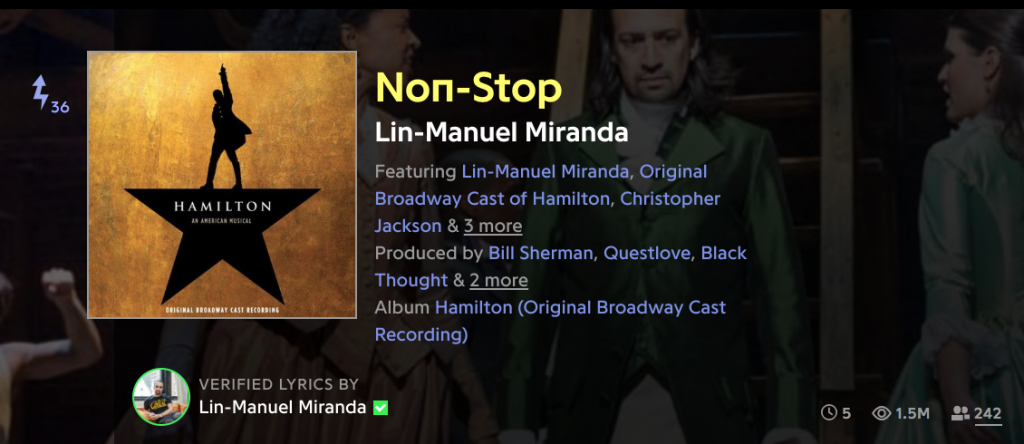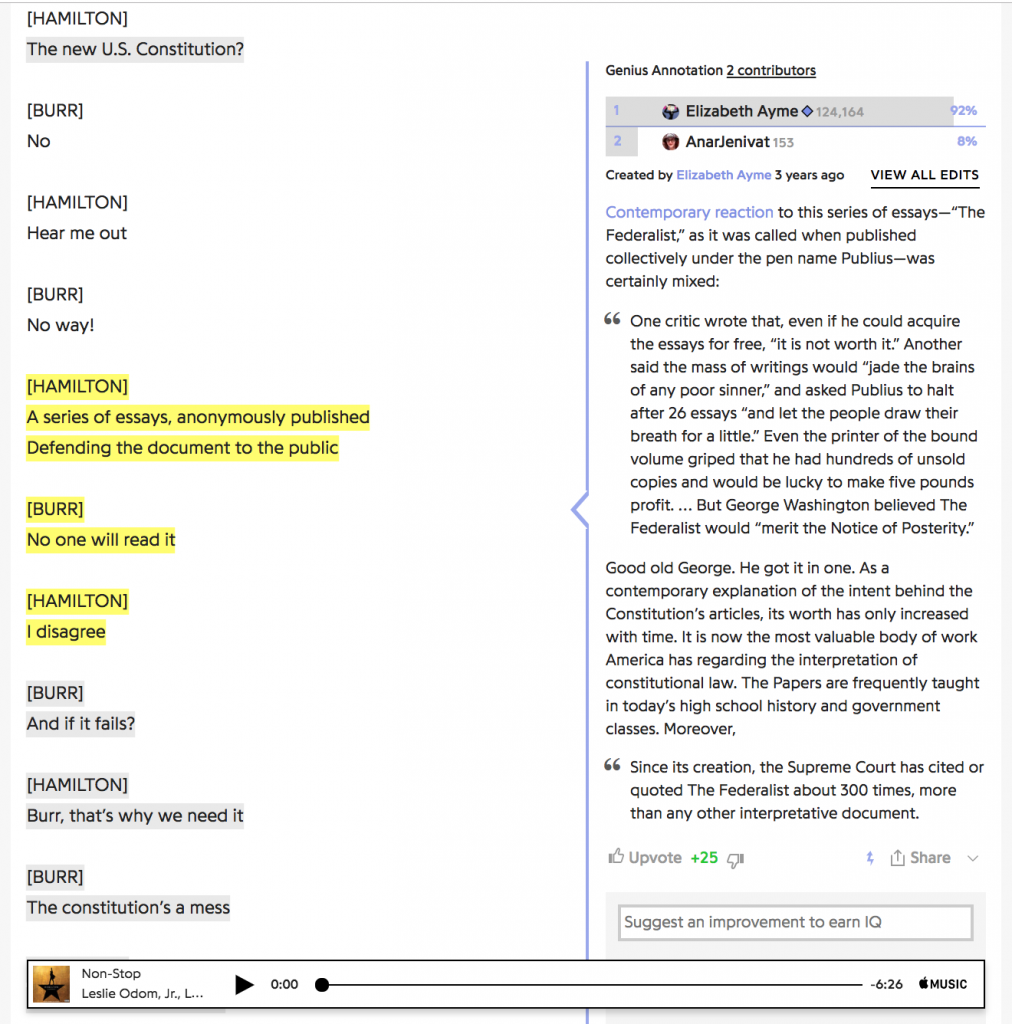Reading Histories
Introduction: Grangerizers, Commenters, and Extra-Illustrators
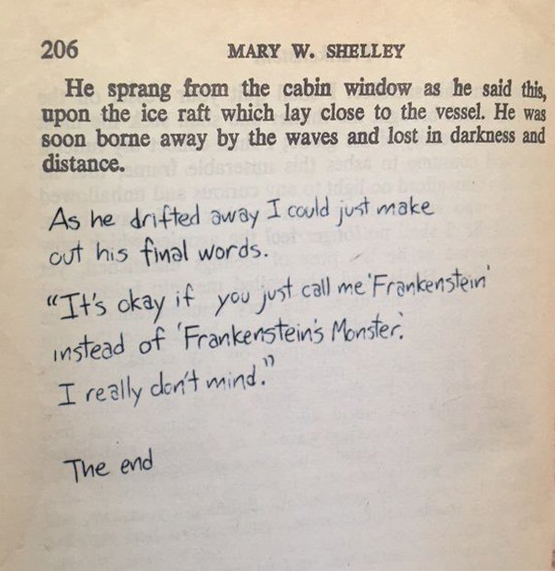
How do you feel about writing in books?
- Do you refuse to take a highlighter or pen to their pages?
- Do you take the middle ground, leaving the faintest of pencil traces (only to furtively erase them before returning the book to the shelf)?
- Perhaps you’re a proud scribbler, adding questions, doodles, and even grocery lists to your texts.
- Maybe you’ve had entire conversations with friends or strangers in the margins of books.
No matter which approach you take, you have something in common with a nineteenth-century reader. People have been writing in books since books were invented, but social and technological changes during the 1800s made this practice much more common. As it became less expensive to print and ship texts, books became accessible to a larger number of people. In Britain, educational opportunities expanded for the middle and working classes, and higher literacy rates further accelerated the demand for print (Hayward 21-22, Darnton 77). The resulting expansion in reading matter was so vibrant that scholars often refer to it as the nineteenth-century “print boom.” With this increase in media accessibility came a separate boom in the range of ways that people interacted with texts—and with one another through texts.
The book you’re reading right now is a critical edition of The Woman in White, a novel that emerged at a time when many of these changes in publishing and circulation were redefining how fiction operated in the world. The supplemental readings in this project will invite you to reflect on the idiosyncratic ways that nineteenth-century readers interacted with literature. Such readers, I hope you’ll agree, were varied, active, purposeful, social, and often wonderfully creative. Learning more about them can help us see the transformative potential of literary texts and literary audiences alike.
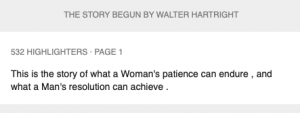
But this project is interested in more than just readers who lived two hundred years ago. Present-day readers are just as varied, active, purposeful, social, and creative as past audiences were. We alter and reinvent the things we read, and our interactions can also be surprising and transformative. Like the Victorians, we’re living during a time when the technologies we use to communicate are changing dramatically. These technologies are reshaping how we learn and what our entertainment media look like.
These are some of the reasons why this edition of The Woman in White is not just a critical edition, but also a participatory edition. We encourage you to shape this text in ways you feel will help others engage with the novel more deeply. If you’re comfortable doing so, we invite you to contribute comments in the social annotation layer, compose footnotes to explain concepts that puzzled or inspired you on first encounter, and share essays of your own for inclusion in this volume.
In many ways, this edition is an experiment. Critical editions of novels are traditionally produced by specialized presses, authored by a small number of experts in the field, and maintained in a fairly static format. But in the present day, new digital platforms and print distribution formats make it possible for us to create a responsive, living text that can evolve into many different forms at once. In this project, we invite you to help us redefine the conventional critical edition of a novel. Your voice matters, and we believe that you have a lot to offer the other readers who will interact with this book. It’s our hope that just like the Victorians, you’ll use the composition tools at hand to tailor your reading and to help others think with you.
There’s a kind of poetic justice to inviting participants to contribute to this edition at a time when the field of literary studies is finally recognizing the ways that readers of all types reshaped Victorian fiction. However, this is not the only reason we welcome you to take an active role in this book. In the last thirty years, a number of evidence-based research studies have suggested that active and social reading practices help people integrate and retain information more effectively. Passively highlighting, underlining, or rereading has been shown to produce limited advances in people’s long-term recall and understanding of a text (Dunlosky 18-21). In contrast, practices that allow for creative exploration can increase people’s ability to learn from and to engage with texts. Effective strategies include actively describing how new information relates to known information and engaging in “elaborative interrogation”—that is, asking and answering questions of your own (Dunlosky 5).
Research studies also suggest that when learners describe new concepts to others, both parties benefit (Cortright et al.). One reason for this is that we often process information differently when we are presenting it to other people. This partly explains why the learning gains for those who teach others are often even more pronounced than the gains for those who learn from their peers. We hope that you’ll enjoy interacting with others by writing annotations and essays for this volume, but we also hope that you’ll find the process of doing so—as well as the opportunity for feedback and exchange that it offers—to be a useful tool.
Our goal for this participatory volume is to celebrate the expertise you can bring to the table, to offer you creative ways of directing your own learning, and to create an ever-improving, living text that others are welcome to use or adapt. As we embark on this path, let’s consider some of the ways that nineteenth-century readers left their mark on Victorian fiction and how these practices resonate in this edition.
19th-Century Strategies
Marginalia
During the nineteenth century, people wrote in books for reasons that ranged from solitary reflection all the way to public performance. Sometimes, people would draw symbols in the margins as a private system of reference. They might also create an impromptu table of contents in the back of a text (Jackson 25). At other times, they would reflect on—or talk back to—an author’s points. Indeed, the naturalist Charles Darwin annotated many of the books he owned in this way. In his copy of Charles Lyell’s Principles of Geology, we can still see Darwin’s reflection on a scientific theory that differed from his own. In an emphatically underlined note, he writes: “If this were true, adios theory” (“Charles Darwin’s Personal Library”).
Just like today, nineteenth-century audiences took pen to page not only to study, amuse themselves, or disagree with an author, but also to connect with one another. For example, each year, publishers would put out decorated gift books around the winter holidays. Many readers used this opportunity to write heartfelt dedications to those they cared for in the fly-leaves or to call attention to significant passages. This is proved an excellent way to remind someone of the gift giver’s feelings or to simply indicate a point that the pair might discuss together in the future (Piper 16). Marginal inscriptions of this sort even fostered political networking and social movements. For example, in her research on gift book traditions, Jill Rappoport has observed that while the Victorian debate over slavery was at its height, many of the gift books that women gave to one another had anti-slavery themes and illustrations (Rappoport 36). Inscribed gift books also supported later efforts to promote women’s rights (Rappoport 10).
Not only did semi-private communication in books flourish during this time, but people were also beginning to value such writing in new contexts. It’s telling that the very word “marginalia” as we know it came to us from the long nineteenth century. As H. J. Jackson observes in her book, Marginalia, while annotated editions had been valued by book collectors for years, the poet Samuel Taylor Coleridge gained remarkable public attention due to his talent for writing in texts (7). Coleridge published some of his marginal notes in Blackwood’s Magazine in 1819, thus coining the word “marginalia” for English usage (Jackson 7). By 1875, there was a broader market for reprints of famous men’s marginalia. For instance, after William Makepeace Thackeray died, the art journalist Joseph Grego capitalized on the public’s love for the author by publishing Thackerayana, a text that included almost six hundred sketches copied from the margins of books in Thackeray’s personal library (Jackson 219n7).
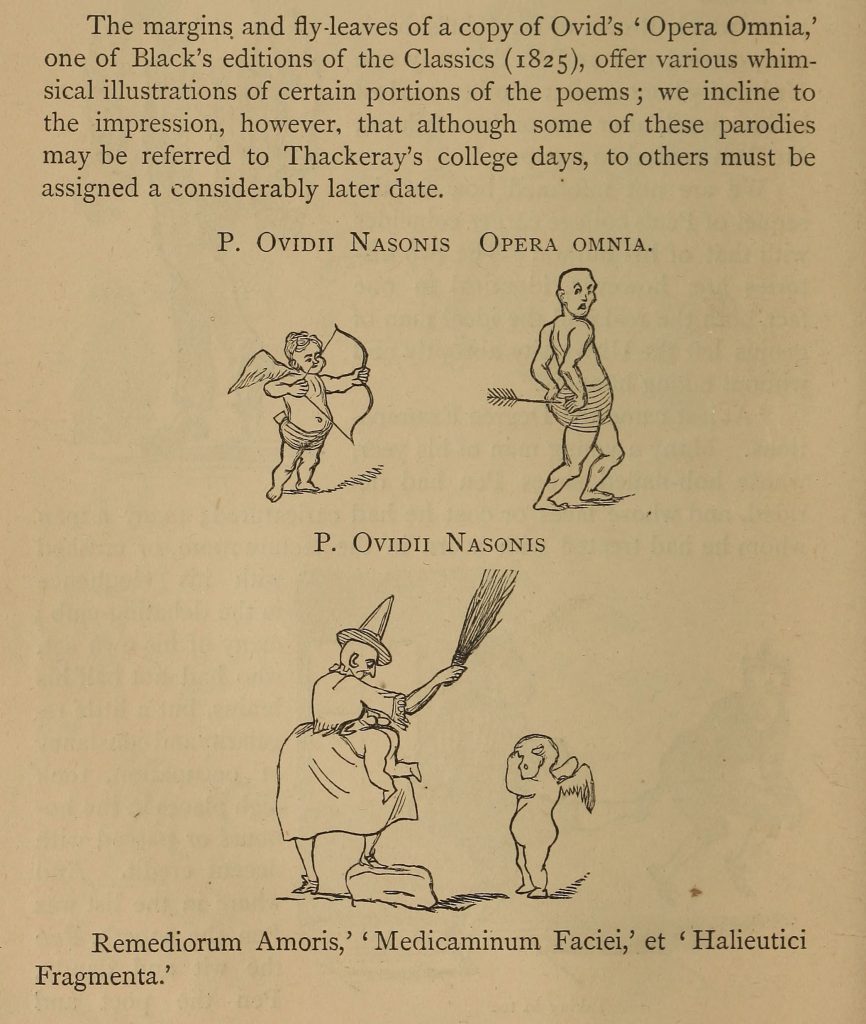
If you were a Victorian reader, you didn’t have to be famous to gain a wider audience for your in-text commentaries. During this period, circulating libraries took on newly influential and accessible forms. This meant that individual copies of books could have a wide circulation of their own. Libraries had existed in Britain prior to the Victorian period, but they were often outside of the reach of non-wealthy people. In the mid-nineteenth century, this began to change. By the 1840s, Mudie’s Select Circulating Library was offering access to its collection at the low rate of one guinea per year, a price that many middle-class families could afford to pay (Griest 17).[1] All of this means that if you were someone who had library access during this period, you just might add some of your opinions to the books you borrowed—and others might even write back. An author in the periodical Chambers’s Journal had a name for these kinds of scribblers: “Circulating-Library Critics,” describing their work in this way:
It is an author’s place to write his work to the best of his ability, and that of his readers to criticize it after it has appeared in print. Whether the book be good or bad, the author may be sure that he will have a faithful and industrious army of critics in the shape of subscribers to circulating libraries, who will diligently search out all its little defects, and display them in the margin for the edification of the next reader, who in turn will try his best to discover something which the other has passed over, and triumphantly display it in a similar manner.
Although ‘the stone that is rolling’ is said to gather no moss, it is a far different thing with a novel, for the faster it passes from hand to hand, the more and more abundant becomes its crop, and at a seaside watering-place, the writer has seen blank sheets of letter-paper inserted between some of the leaves, because the margins were already too crowded, to admit of some reader adding his mite to the evidence thus accumulated!” (“Circulating-Library Critics,” Chambers’s Journal, 1884, 81)
Not all library books took on this degree of reader commentary, of course. However, the Chambers’s Journal essayist puts a finger on the broader implications of practices like these. Whenever more people’s voices can be amplified through a book than just an author’s, some of the traditional power dynamics of publishing shift. For this essayist, part of the pleasure of reading is thanks not just to the writer, but to the audience: we’re told that the essayist “know[s] of nothing more enjoyable than a well-read book, which has been some ten or twelve months in circulation” (81). More than this, the essay suggests, such volumes could prove quite useful to their writers in the future because readers’ suggestions might outshine or improve the original version of the text. The essayist suggests that “such a book would without a doubt prove of great service to the author . . . if he has good sense and a desire to please the public, he would avail himself of those critical remarks which seemed to be just, and alter the text in any future editions” (81). In a democratizing world of print, writing in books could have powerful effects.
This idea of readers as active respondents who might influence an author or usurp that author’s audience pervades many Victorian novels and essays. Indeed, as you read The Woman in White, you’ll see fears about this possibility cropping up in the narrative. One of Collins’s most suspenseful scenes involves an antagonist claiming the margins of a text as a space of his own.
Scrapbooks, Extra-Illustrations, and Grangerized Texts
The strategies that nineteenth-century readers used to alter texts go beyond marginal notes or the occasional doodle. Because books, magazines, reprints, and used volumes were growing more easily accessible, there were fewer cost limitations associated with modifying and remixing them more dramatically. Three overlapping traditions that gained popularity as a result were scrapbooking, extra-illustration, and grangerization.[2]
Scrapbooking
Of these three practices, “scrapbooking” is the term that has the widest prevalence in English today, and some Victorian scrapbooks bear a striking resemblance to their later descendants. Nineteenth-century scrapbooks could include photographs or prints that reminded their creators of family members, experiences they had had, or plays they had seen. Creators included pictures from any number of sources including advertisements and cut-up books or magazines. Some creators even put their artistic talents to use by creating trompe l'oeil details (Pettit 21). Rather than trying to create the impression that their scrapbooks were seamless productions that came straight from the printer, the artists who included these three-dimensional illusions emphasized the constructed nature of their texts.
While many scrapbooks had visual and decorative elements, one dynamic that may surprise you is the lack of pictures in other nineteenth-century scrapbooks. Ellen Gruber Garvey, one of the foremost experts on nineteenth-century print culture, describes “clipping scrapbooks” as a creative response to the print boom. With affordable publications came the possibility that a family would accumulate more newspapers and magazines than they could keep (“Scissoring” 209). Thus, she writes,
Readers adapted to this proliferation of print by cutting it up and saving it, reorganizing it, and sometimes recirculating it. . . . [E]ach clipping scrapbook maker too created a private and idiosyncratic catalog, a reflection of personal identity made from mass-produced and distributed publication. (“Scissoring” 209)
In a time before word processors or affordable home printers, scrapbooking was one way to compile volumes that resonated with a specific individual or social group. In this way, the print boom created the conditions for people to take on roles that were otherwise reserved for magazine editors or compositors. They could omit extracts they felt to be irrelevant or deliberately place two articles next to one another to intensify an effect.
Once again, we can see a link between this reader practice and the world Wilkie Collins describes in The Woman in White. Even the opening conceit of the novel suggests that an editor has the power to influence readers’ ideas and emotions. As the character Walter Hartright informs us in the first few pages of the tale, this text is organized as a series of separate narratives written by people who have different relationships to the action. Hartright is playing the role of editor insofar as he has commissioned or collected each of the written narratives to arrange into a broader text assemblage. Hartright tells us that his goal is to use these documents to convince readers to judge him fairly. Like a scrapbook creator working after the fact, however, Hartright is working with documents whose authors’ perspectives don’t always align. Nevertheless, his editor role allows him some agency in how he presents and arranges these documents. He gets to decide which sections of a diary to include or omit, and he also gets to introduce others’ points in strategic ways. As you read this novel, think about how Hartright’s prefaces and content organization shape your perceptions of other characters.
We also encourage you to consider how your own reading tools in the present day may resemble earlier scrapbooking traditions. if you’re interacting with the web version of this novel, you can use the Hypothes.is annotation tool to create a private ‘clipping scrapbook’ of your own–that is, you can tag and collect quotations by theme and view them all on the same webpage. Likewise, many e-readers have a highlighting function that will allow you to look back at a collected list of the passages in a text that you’ve digitally highlighted. What does looking back at your own virtual ‘clipping scrapbook’ tell you about your experience as a reader and scholar? Which of the character narratives excerpted in The Woman in White plays the biggest role in your clipping scrapbook? Why do you think this is?
Extra-Illustration and Grangerizing
The practice of extra-illustration is related to scrapbooking in that it involves adding visual and sometimes print elements to texts. Unlike a scrapbook, however, an extra-illustrated volume is typically an expanded version of a single text, meaning that it typically uses one book as a kind of backbone for other media to attach to (“Imitation” para 14). Extra-illustration could involve drawing directly in a book, cutting out images from other sources and pasting them into the text, or commissioning artists’ renderings to include alongside a relevant scene. The practice was so popular in Britain and America that new media forms emerged to satisfy these enthusiasts: Victorians could buy sets of illustrations that were created specifically to allow readers to insert them into their books.
Extra-illustration overlaps with the practice of ‘grangerizing’ texts—(and, indeed, the terms are sometimes used as synonyms). In the following extract from a 1903 instructional book, the author describes these pastimes in the following manner:
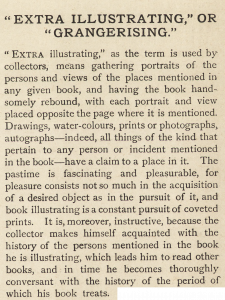
As this author suggests, grangerizing and extra-illustrating frequently involved taking apart the entire text and binding it in a new and expanded form. Yet people approached this process in a lot of different ways. In the next image, we can see Ethel Webling’s marginal illustrations of characters in Shakespeare’s Twelfth Night. These illustrations overlap the words on the page, but the ink wash is light enough to see the printed text underneath.
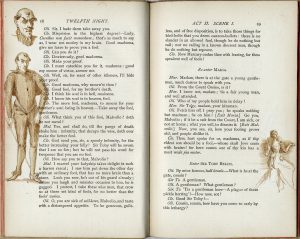
Extra-illustrated and grangerized editions share some features with scrapbooks in that they were creative, media-rich, and social: people often enthusiastically showed or lent their creations to others. Grangerizers could infuse a great deal of personality into their work. Creators viewed books as blank canvases and did not let the ‘original’ arrangement of the book get in the way of contributing new media to the text. As we can see in the Home Arts and Crafts excerpt, many found the process of grangerizing or extra-illustrating texts to be both enjoyable and educational.
You, too, are welcome to contribute new media to this text! We hope you find it enjoyable and educational as well.
Why call this text a “grangerized” edition?
The practices we’ve just touched on are, of course, what inspired the name of this edition: The Woman in White: Grangerized. However, this is a title I originally had mixed feelings about. You see, there are important reasons why the word “grangerized” isn’t an apt description of what this participatory edition is trying to do—that is, if we adhere to the strictest understandings of the art.
First, many early ‘grangerizers’ had elitist and exclusionary attitudes. Because of the time and money involved in collecting prints to integrate into a text, grangerizing provided opportunities for wealthy people to compete with one another through conspicuous consumption (“Imitation” para 15). For instance, in the late eighteenth century, English grangerizer Richard Bull made a habit of writing notes about the rarity of prints and the high prices he paid for them in his volumes (Wark 157). People also tended to pick texts to grangerize that signified higher-class status. Collins’s popular sensational novel was unlikely to be high on people’s lists of texts to grangerize because of its appeal to the middle and working classes. In fact, the most class-obsessed grangerizers even developed expensive visual codes to ensure that their creations stood apart from those of less well-to-do readers. As Ellen Gruber Garvey informs us:
To ensure that the extra-illustrated book would not be mistaken for a scrapbook, one authority explained that grangerizers should add magazine and newspaper articles only if they had the paper split (literally separating its front and back faces), so that type appeared only on one side—something the average scrapbook-maker could not afford. Such an article would evidently be valued for its now specialized visual qualities and the expense of preparing it for extra-illustration, not just for its particular content. (“Imitation” para 16)
For some Victorians, showing off a grangerized text was more of a class performance than an invitation to connect.
In contrast, our goal in this volume is to create a text that is easy to access and reproduce in multiple forms. Rather than scouring the world for the most expensive prints, I have scoured digital archives for unrestricted public domain images that anyone can use. Providing no-cost downloads of this text and linking to resources that don’t demand royalties is our way of working against the cost limitations that can keep people from participating in humanities scholarship. When at all possible, my goal is for the resources and images in this text to be openly remixable: they are based on open-source software when possible and are filled with public domain and Creative Commons licensed images you can adapt as well. The people involved in creating this text believe that the more people who are able to participate in conversations about literature, the better.
There’s a second way that the term “grangerized” might clash with this text’s goals. Because some grangerizers craved status and competition, texts could become vast collections of prints that were included for the sake of ‘completeness’ rather than relevance or coherence. When adapting James Granger’s Biographical History of England, for instance, Richard Bull includes sixty portraits of James I alone, and the resulting project ballooned into nineteen separate volumes (Wark 156-57). Sometimes, this encyclopedic drive led people to insert prints that had only the most tenuous and unexplained connections to the words on the page. Of course, there’s nothing inherently wrong with this kind of extensive cataloging. However, the objectives of this participatory edition are best achieved through focused forms of reflection and engagement rather than extended cataloging. This text’s annotations and other additions exist to support those goals in an intentional, focused way.
Having recognized these differences, as this volume’s editor, I ultimately decided to reclaim the word “grangerize” for this text. One motivation was that I enjoy the thought of taking some of the more elitist philosophies associated with nineteenth-century books and turning them on their heads. Added to this, even though some grangerizers were interested in creating exclusive texts, this was not a universal attitude. The history of grangerizing and extra-illustration also highlights some of the many ways that print became more democratically available during the long nineteenth century.
Epilogue: New Media, New Marginalia
Fast-forward to the present day and you’ll see audiences interacting with media in ways that Victorians could never have imagined. In internet resources such as Genius.com, readers across the globe can post explanations, hyperlinks, and other media forms that are instantaneously visible to anyone with the requisite internet access.
Fig. 3: Genius.com annotations to Lin-Manuel Miranda’s song “Non-Stop.” (21st-Century.) [Long description.]
Key Takeaways
- Twenty-first-century audiences and nineteenth-century readers have a lot in common. During both centuries, the tools we use to communicate changed dramatically.
- Advances in printing technology increased nineteenth-century readers’ access to books, increasing the number of people who were able to personalize written texts in creative ways.
- As people customized texts to meet their own needs, new ways of connecting with–or excluding–other readers emerged.
- As you engage with this text, we invite you to think about your own interactions with new and old media as a way to learn more about ‘old media’ and to connect with other readers in the present day.
Works Cited
“Charles Darwin’s Personal Library Goes Public.” National Endowment for the Humanities (NEH), https://www.neh.gov/news/charles-darwins-personal-library-goes-public. Accessed 23 Feb. 2019. Permalink: https://perma.cc/68QM-D8V8.
Cortright, Ronald N., Heidi L. Collins, and Stephen E. DiCarlo, “Peer Instruction Enhanced Meaningful Learning: Ability to Solve Novel Problems.” Advances in Physiology Education, 1 June 2005. DOI: 10.1152/advan.00060.2004.
Darnton, Robert. “What is the History of Books?” Daedalus, 1982, pp. 65-83.
Darwin, Charles. Marginal annotation on page 442 of Principles of Geology. Darwin’s Manuscripts Project, https://biodiversitylibrary.org/page/33949861. Accessed 10 January 2019.
Griest, Guinevere L. Mudie’s Select Library and the Victorian Novel. Indiana University Press, 1970. OCN: 16203315.
Gruber Garvey, Ellen. “Imitation Is the Sincerest Form of Appropriation: Scrapbooks and Extra-Illustration.” Common-Place, vol. 7, no. 3, 2007. http://www.common-place-archives.org/vol-07/no-03/garvey/. Permalink: https://perma.cc/3X8M-TF3E.
Hayward, Jennifer. Consuming Pleasures: Active Audience and Serial Fictions from Dickens to Soap Opera. University Press of Kentucky, 1997. OCN: 818184744.
Miranda, Lin-Manuel, with annotators Elizabeth Ayme and AnarJenivat. “Non-Stop” Annotations. Genius.com. Accessed 29 October 2018. https://genius.com/7873626.
Pettitt, Clare. “Topos, Taxonomy and Travel in Nineteenth-Century Women’s Scrapbooks.” Travel Writing, Visual Culture and Form, 1760–1900, edited by Mary Henes and Brian H. Murray, Palgrave Macmillan UK, 2016, pp. 21–41, doi:10.1057/9781137543394_2.
Piper, Andrew. Dreaming In Books: The Making of the Bibliographic Imagination In the Romantic Age. University of Chicago Press, 2011. OCN: 833574331.
Rappoport, Jill. Giving Women: Alliance and Exchange In Victorian Culture, Oxford University Press, 2012. DOI: 10.1093/acprof:oso/9780199772605.001.0001; OCN: 773828488.
Thackeray, William Makepeace, and Joseph Grego. Thackerayana. Chatto and Windus, London 1875, p. 63. Internet Archive, https://archive.org/details/thackerayana00greg/page/62. [Public Domain.]
Webling, Ethel, and William Shakespeare. Extra-illustrated excerpt from Twelfth Night, Act II, Scene I. Twelfth night; or, What you Will: A Comedy in Five Acts by William Shakespeare; As Arranged for the Stage by Henry Irving, and Presented at the Lyceum Theatre, 8th July, 1884. London, Chiswick Press, 1884, pp. 18-19. Folger Shakespeare Library, ART Vol. a75, Digital Image 1093, https://luna.folger.edu/luna/servlet/detail/FOLGERCM1~6~6~8396~100243:Twelfth-night–or,-What-you-will. Permalink: https://perma.cc/QAS9-5HC5. [Creative Commons License – Attribution Share-Alike: CC BY-SA 4.0]
- This price was at the lower range of Mudie's subscription offerings. The amount you paid determined how many books you were able to take out at one time. For one guinea, you could check out one volume (38). In the days of the three-volume novel, this meant that you might find yourself waiting impatiently for someone else to return Volume 3! Just like people sharing Netflix or wifi passwords today, sometimes neighbors went in on larger library subscriptions together (Griest 39). ↵
- I'm writing this text using the American spelling of this word, but you'll see it referred to in primary and secondary sources both as "grangerizing" and "grangerising"—the British variant. ↵
The period between 1789 and 1914--that is, between the French Revolution and WWI.
"Visual illusion in art, especially as used to trick the eye into perceiving a painted detail as a three-dimensional object." - Oxford Dictionary

